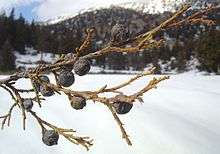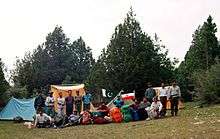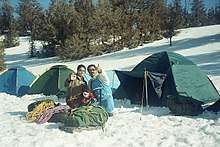Juniperus macropoda
Juniperus macropoda (Pashto: اوبښته ōbəx̌ta, "[a species] which sucks water"), also called Juniperus excelsa polycarpos, or the Pashtun juniper (Pashto: پښتني صنوبر), is a putative species of juniper native to northern and central Balochistan in western Pakistan, and southeastern Afghanistan.[1]
| Juniperus macropoda | |
|---|---|
| Scientific classification | |
| Kingdom: | |
| Division: | |
| Class: | Pinopsida |
| Order: | |
| Family: | |
| Genus: | |
| Species: | J. macropoda |
| Binomial name | |
| Juniperus macropoda | |
Description
A tall tree for a juniper, specimens can be extremely long-lived.it can go up to a height of 20 40 meters in height[2] According to some estimations its age ranges from 2000 to 2500 years.[3] [4]

Distribution
A substantial but dwindling forest of Juniperus macropoda is found in Ziarat District and Kalat District, as well as Zarghun Ghar near Quetta and Harboi including some are found in Koh-i-Takatu and Koh-i-Murdaar in northern and central Balochistan, Pakistan and surrounding parts of southeastern Afghanistan. The largest compact block lies near Ziarat on an approximate range of about 700,000 acres (2,800 km2) [4] and is known as among the largest and oldest juniper forests in the world.in Kalat too many junipers in the fabled forest of Harboi have roots ringed with black soot remnants of many happy picnic visitors but symbolic of the stinging apathy of locals and a state that doesn't place preservation high on its list of priorities.
Threats
On October 29, 2008 a 6.4 magnitude earthquake hit Ziarat and surrounding areas. After the earthquake disruptions the local villagers are now using Juniper trees as fire wood.

The juniper forest area is declining day by day there is lack of substantial remedial steps to minimize pressure on juniper cutting has ever been taken to save the centuries-old valuable trees. The local people living in these areas are not provided with the basic necessities of life.

So, they exploit the forest resources for fuel, shelter and food. The major reason of decline of this forest is uses as firewood for daily use, timber for construction, hedges around agricultural fields by the local communities is resulting change in the environment and endangering the rare species of wildlife. Other threats to Juniper include the smuggling of juniper seeds and attack of plant parasite known as mistletoe (Arceuthobium oxycedri) which destroys it in short period.
On 25 October 2010 The Government of Balochistan Sports, Environment and Youth Affairs Departments announced the Silver Jubilee “Juniper Defender Award” to Hayatullah Khan Durrani, for his long outstanding efforts as juniper defender since 1984. Hayat Durrani is an environmental analyst for the preservation of the 3000-year-old World Heritage of Juniperus macropoda Juniper forests and wildlife in the Ziarat and Zarghoon Ghar regions of Balochistan Pakistan.[5] [6]
Bushes / Ground Flora
There are many important species, bushes and ground flora etc. found here are associated with this species. Local people use ground flora and these plants as indigenous treatments for a variety of diseases.
References
- Shah, Syed Ali (July 10, 2013). "In Balochistan, an ancient forest battles for survival". Dawn. Retrieved August 13, 2013.
- "NAL Online Catalog - AGRICOLA". agricola.nal.usda.gov.
- http://www.wwfpak.org/ecoregions/JuniperForests.php / WWF Pak
- "Pakistanpaedia - Forests of Pakistan (Juniper Forests)". pakistanpaedia.com.
- International Juniper Defender Award conferred to Hayatullah Khan Durrani and Silver Jubilee Juniper Defenders camp in Ziarat >
- "Juniper Defenders camp held - Pakistan News Express". pakistannewsexpress.com.